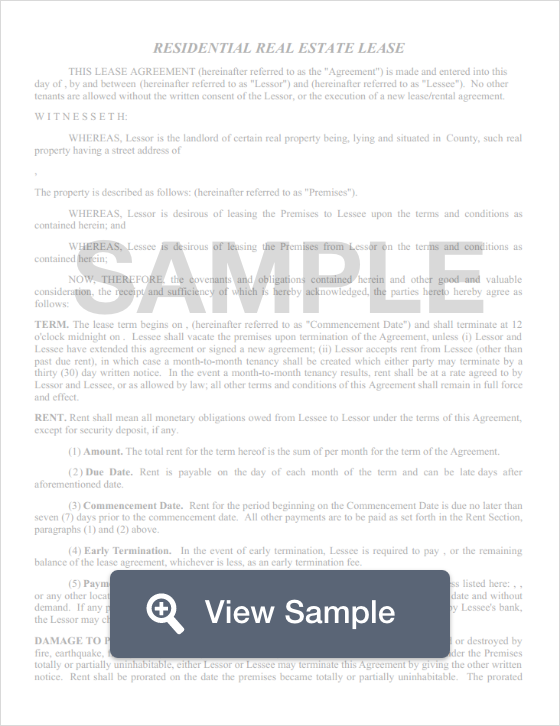Make a Ohio Lease Agreement
Create an Ohio Lease Agreement with our customizable template!

What Is an Ohio Lease Agreement
An Ohio lease agreement is a contract between the landlord or the property management company and the tenants who wish to rent a specific property. Once the contract is executed by the parties, the tenant is then able to take legal possession of the property. An Ohio lease agreement can be used for residential or commercial property.
Looking for other Ohio documents?

Business
- Ohio Non-Compete Agreement
- Ohio Non-Disclosure Agreement
- Ohio Promissory Note

Personal
- Ohio Last Will and Testament
- Ohio Living Will
- Ohio Power Of Attorney

Real Estate
- Ohio Bill Of Sale
- Ohio Eviction Notice
- Ohio Month-to-Month Lease Agreement
- Ohio Quit Claim Deed
- Ohio Rental Application
- Ohio Sublease Agreement


Sample Ohio Lease Agreement


Search Documents
Related Documents
Looking for other Ohio documents?

Business
- Ohio Non-Compete Agreement
- Ohio Non-Disclosure Agreement
- Ohio Promissory Note

Personal
- Ohio Last Will and Testament
- Ohio Living Will
- Ohio Power Of Attorney

Real Estate
- Ohio Bill Of Sale
- Ohio Eviction Notice
- Ohio Month-to-Month Lease Agreement
- Ohio Quit Claim Deed
- Ohio Rental Application
- Ohio Sublease Agreement
Most Commonly Used Ohio Lease Agreements
The most commonly used Ohio rental lease agreements are standard Ohio lease agreements for residential units, month-to-month lease agreements, lease to own agreements, sublease agreements, roommate agreements, and a commercial lease agreement.
Although the most commonly used Ohio lease agreements rely on the same elements, they also have their own functions. Here are a couple of examples.
- A roommate agreement contains the same elements as a residential lease. It also explains which areas of the rental are for the sole use of the roommate and which areas are for the use of all of the occupants.
- A standard residential lease agreement is generally for one year. When the year terminates, it may renew for another year or it may switch to a month-to-month agreement. However, a one-year term agreement and a month-to-month agreement are similar in many ways. One of the most common similarities is found in the requirement of a 30-day written notice to move out at the end of the agreement if one of the parties does not plan to renew the agreement.
How to Write an Ohio Lease Agreement?
An Ohio lease agreement must adhere to Ohio landlord-tenant laws. If they don’t follow the law, they cannot be enforced. There are other laws that must also be considered. You’ll learn about some of those under the sections related to disclosures and security deposits.
Prior to signing an Ohio lease agreement, you should read the terms carefully or have it reviewed by an attorney.
An Ohio lease agreement should include:
- Names of the Property - This is the landlord’s full name or the property management company’s legal business name and the legal name of the tenant(s).
- Property Address - This is the street address for the rental property, including the city, zip code, and, if applicable, the lot or unit number.
- Term Information - This is the type of lease agreement the parties agree to enter into. For example, a month-to-month lease or a fixed term. A fixed-term lease means that the parties agree that the tenant will hold possession of the space for a certain amount of time, usually one year. If it is a fixed lease, this section should include the date that the lease will end.
- Rental Amount - This section includes the date that the lease will begin, the amount of the monthly rent, the day of the month that rent is due, and the address where the rent may be paid.
- Late Fee - This section documents the amount of the fee that is due if the rent is not paid by a certain date.
- Security Deposit - This is the amount of money that must be paid in advance of the tenant taking control of the property. A security deposit is used to repair damages caused by the tenant.
- Initial Payment - This is the total amount of money that the tenant must pay to move into the rental property or unit. This should include the amount of the first month’s rent, the security deposit, and the total of the two numbers added together.
- Occupants - This section includes the full name of each tenant even if they are a minor or are not signing the lease. This part of the Ohio residential lease agreement establishes who will reside in the residential unit. For commercial space leases, it designates those who have permission to use the space. If the presence of additional occupants changes the price of the rent, it should be included in this section.
- Utilities - This section explains which utilities or services a tenant does not pay.
- Parking - This section informs the tenant if they will receive a parking space. If a parking space is reserved and there is a designated spot, the spot should be listed in this section.
- Furnishing - This section tells tenants what they are allowed to install (such as a dishwasher or washing machine) or what they may not install. If the tenant is not allowed to bring their own appliances, that should be designated in this section.
- Notices - This section documents the names of the landlord or property manager and tenant along with their mailing address. This contact information is used if the parties need to send out a notice to the other party.
- Additional Terms - This section lists any other terms that the parties agreed to that haven’t been included in any other section of the lease agreement.
- Signature and Date - The document should be signed and signed and dated by all parties.
Which Disclosures Belong in an Ohio Lease Agreement?
The only disclosure required is for residential units built before 1978. A lead based paint disclosure must be given.
What You Need to Know About Ohio Lease Agreements
The State of Ohio requires security deposits to be held in an interest-bearing account if the security deposit is in excess of $50 or more than one month's rent. The interest-bearing account must earn 5% per year if the tenant stays on the premises for at least six months. Under Ohio law, there is no cap on how much a landlord may request for a security deposit. The security deposit and the interest must be returned within 30 days of the end of the lease.

Create a Ohio Lease Agreement in minutes with our professional document builder.













